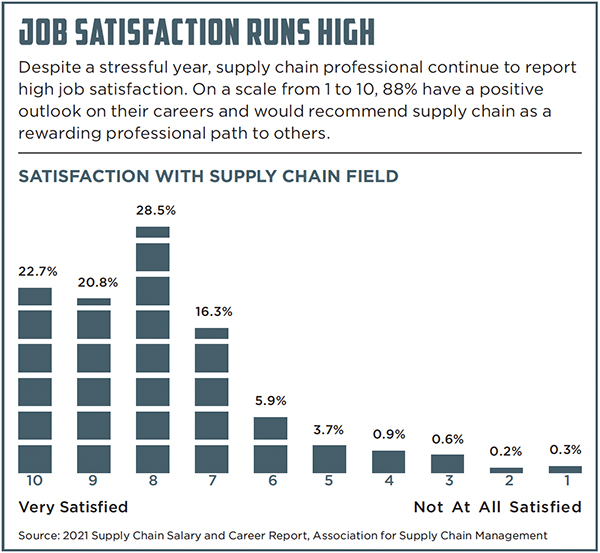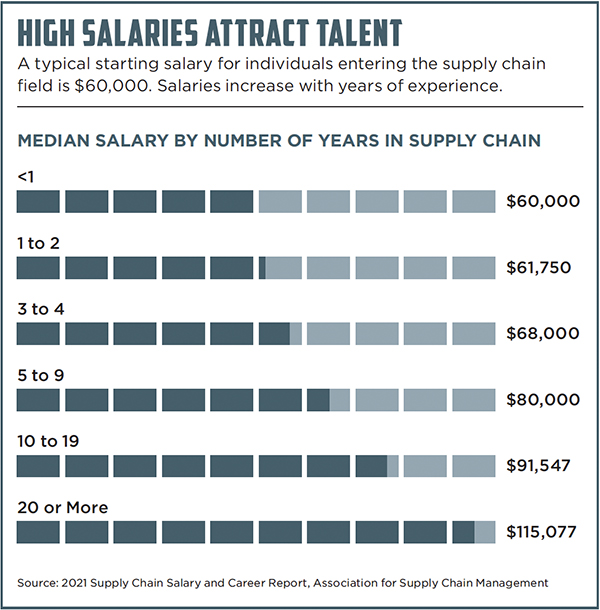Cultivating Supply Chain Talent

2021 was notable for labor challenges and shifts in thinking about employee engagement. Here’s how to attract supply chain talent and increase job satisfaction.
Trident Transport knows the value of employee engagement. The Chattanooga, Tennessee-based freight broker provides extensive employee training peppered between fun company events and community outreach. From intramural team sports and costume contests, to an annual cornhole tournament raising money for the local children’s hospital, Trident places a heavy focus on workplace culture.
“On a basic level, we want our employees to enjoy where they work,” explains Katelyn Clark, Trident Transport’s director of people and culture. “Logistics can be stressful at times. We want to create an environment where employees are happy to come to the office each day.”
That commitment pays off. The company is expanding, even as a talent gap stretches across most parts of the supply chain. While Clark agrees that there is currently a worker shortage, she says Trident has mostly managed to avoid it. “Employees left and right refer friends or past co-workers to the company,” she says. “We’re actively growing.”
That hasn’t been a universal experience. A 2018 Deloitte study—conducted well before the pandemic began—predicted a 2.4 million worker shortfall by 2028 in manufacturing alone. Today, 90% of CEOs say that a labor shortage is impacting economic growth, finds the U.S. Chamber of Commerce.
The problems plaguing supply chain employment come in a few forms, and many of them are beyond the sector’s control.
For one, the economic environment hasn’t been kind to employers. The labor force participation rate, a measure of how many people in the United States currently hold a job, is at 61.6%, a record low. And 11 million positions remain unfilled while 7.6 million Americans are out of work, according to the Bureau of Labor Statistics. In this environment, few industries can escape the talent crunch.
At the same time, this employment nadir comes at a moment when demand for supply chain management talent has reached a new high. So what’s an executive to do?
Lean Into Professional Development
Fortunately, companies looking to shore up supply chain talent have plenty of options. Data from the Bureau of Labor Statistics shows that, on average, job tenure across sectors is 4.1 years. It shrinks to 2.8 years for workers between the ages of 25 and 34. Emphasizing professional development can mitigate some of the restlessness that drives employees to leave, according to Dr. David Huff, clinical professor of supply chain management and director of online graduate programs in supply chain management at Penn State Smeal College of Business.
An important step is mapping out career progression. Huff recommends that managers prioritize career path conversations as a means of keeping employees excited about what the future holds.
“People need to have professional development opportunities,” says Huff. “They need to know not just what’s happening right now, but what the job looks like five years down the road.”
That necessitates that employees be given additional responsibilities as they grow in their role.
“Employees need to see that they will be given more responsibility,” Huff says. “Making a career path clear isn’t helpful if the roadmap reads, ‘you’re not going to move anywhere.’
“People need to see that they will get opportunities to get deeper into the big decisions,” he adds. “Being relied on and driving important outcomes creates job satisfaction.”
Another opportunity for professional growth comes through continuing education. It’s an approach that Blume Global is familiar with. The San Francisco-based provider of supply chain technology solutions recently launched initiatives through the online learning platform Coursera and the Stanford Graduate School of Business.
“Every one of our employees gets a Coursera membership,” says Pervinder Johar, global CEO. “They get the certifications they need for their job, but they can also explore new skills that are relevant to their career goals.”
The educational opportunities don’t stop once staff members reach a senior position, either. Directors and above at Blume Global attend a week-long management program at the Stanford Graduate School of Business.
“None of us are born a manager,” Johar explains. This program gives workers the structure and tools needed to grow in upper management roles.
“The net result is that we end up with a highly innovative culture focused on building something new,” he adds. “It opens our minds to new possibilities, which is our end game—continuing to innovate and think outside the box.”
Recruit With a Cause
Managing a firm’s public image has never been more important than it is in the internet age. Prospective employees increasingly care about their employer’s role in human welfare. This has its upsides. Throughout 2020 and 2021, countless examples illustrate the role of supply chains in day-to-day life. Consumers got a close look at how everything from soup cans to lifesaving COVID supplies make it to their final destination.
Playing up the social impact of supply chain management can help attract new employees.
“The role of the supply chain professional has expanded beyond getting products to individuals,” says Abe Eshkenazi of the Association for Supply Chain Management in Chicago. “Now we’re concerned about human rights and the environment.
“If an individual wants to have an impact through their job, not only on their company but on people across the globe, I cannot think of a better opportunity than supply chain today,” he adds.
Emphasizing social causes can also test a company’s public relations team. Prospective employees care about their employer as a brand, and firms are well advised to be cognizant of their image.
“People are much more concerned about corporate social responsibility,” says Tom Martin, solutions director for learning at the Institute for Supply Management in Tempe, Arizona. “They interview the company before they go to work there. Everyone is much more concerned about being affiliated with a brand name that is well represented or highly thought of.”
Appeal to Yound Professionals
Corporate image is particularly important for attracting idealistically minded young employees. According to a recent Council of Supply Chain Management Professionals/Penske survey, 58% of professionals under age 30 who entered the field in 2021 did so because of its beneficial impact. Companies can capitalize on that enthusiasm by offering high-quality internships and focusing on mentorship.
“Companies have to give younger employees regular feedback on performance and show them what their career path looks like,” explains Craig Robins of Robins Consulting, a logistics recruiting firm based in Dallas. “It helps them feel valued and lets them know that they are important to the overall objectives of the company. That’s what younger people are really looking for.”
If making a meaningful contribution is what initially reels in young recruits, job satisfaction is what keeps them in a role. In the same Penske survey, 99% of young people agree that supply chain management is a quality career choice, and 80% say that their jobs are better than most others. Young professionals are excited about the variety of career opportunities, and the fast-paced, challenging environment that comes with solving complex supply chain problems.
“A lot of companies are realizing that the new generation coming up is very different than employees were even 10 or 20 years ago,” says Robins. “Younger employees expect more transparency and teamwork. This is very important.”
A Solid Career Choice
The secret to growing company payrolls could be promulgating the upsides of a career in supply chain management. There are plenty of benefits to be had in this field, especially in uncertain times.
On a practical level, there’s compensation and job security. In the past year, median annual salary reached $86,000, according to the Association of Supply Chain Management’s 2021 Supply Chain Salary and Career Report.
Wages typically start at $60,000, but could more than double for professionals with longer tenure. In comparison, median earnings for all U.S. workers in the second quarter of 2021 translate to slightly more than $50,000 per year, shows data from the Bureau of Labor Statistics. At the same time, 87% of supply chain professionals received a bonus in 2020, and only 5% reported getting laid off last year.
Job satisfaction runs high, too—88% of respondents say they would recommend to others supply chain as a profession.
“We have to create better press about ourselves,” says Martin. “Supply chain management jobs are very interesting and provide an opportunity to learn about every aspect of a business. These roles are highly visible, and there’s great opportunity for innovation.”
Mike Coxon, a partner with McKinsey & Company in Cleveland, Ohio, agrees. “There should be tremendous excitement about what’s possible in supply chain management right now,” he notes. “There’s ripe opportunity for people who want to go into a career with technology and analytics.
“There’s a chance here to reset the mindset about what a supply chain career offers,” he says. “Getting people to recognize how exciting it is could solve some of the talent shortage.”


